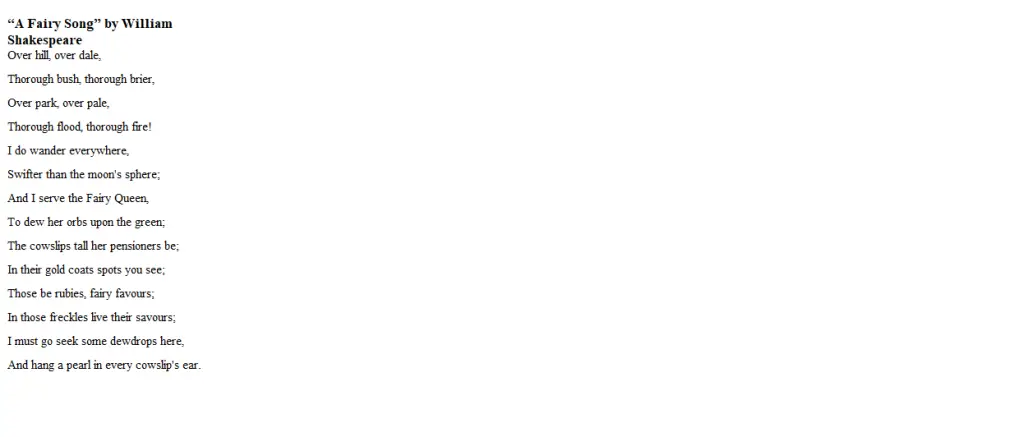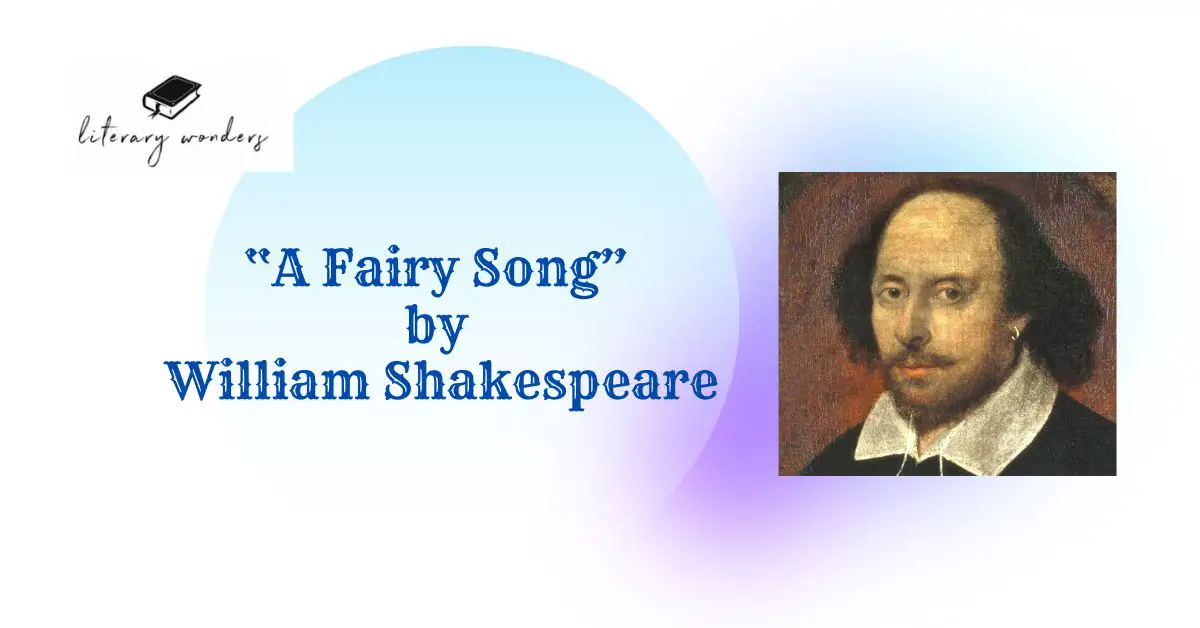“A Fairy Song” by William Shakespeare

- Summary Of “A Fairy Song”: A Fairy Song” by William Shakespeare is a whimsical and enchanting poem that captures the essence of a magical world. The speaker, presumably a fairy, joyfully expresses their travels through various terrains like hills, dales, bushes, and parks, even crossing obstacles like floods and fires. This fairy’s journey is characterized by its speed, claiming to move swifter than the moon’s orbit.
- The fairy serves the Fairy Queen and takes on the delightful task of adorning the greenery with dewdrops. The cowslip flowers are highlighted as the Queen’s attendants, adorned with golden coats with ruby-like spots. These spots are described as fairy favors, containing the essence of the flowers’ fragrances within their freckles.
- The poem concludes with the fairy’s intent to gather dewdrops and place a pearl in each cowslip’s ear. This imagery showcases the magical and ornamental nature of the fairy’s role. Through vivid imagery and a rhythmic flow, Shakespeare’s “A Fairy Song” invites readers into a world of wonder, where the boundaries between nature and magic blur, and the ordinary becomes extraordinary under the influence of the Fairy Queen and her ethereal attendants.
- Representation of the Natural World in “A Fairy Song”: In “A Fairy Song” by William Shakespeare, the representation of nature is vivid and enchanting, woven seamlessly with elements of magic and wonder. The poem paints a picture of a fantastical realm where nature is alive with mystical qualities. The opening lines, “Over hill, over dale, Thorough bush, thorough brier, over park, over pale,” evoke a sense of movement and traversal through diverse landscapes, highlighting the expansive and unrestricted nature of the fairy’s domain.
- Nature is portrayed as a place of both beauty and challenge as the fairy navigates through bushes, briars, parks, and even over obstacles like fences and floods. The mention of “Thorough flood, thorough fire” implies that the fairy’s connection with nature transcends even the most extreme elements.
- The cowslip flowers, personified as the Queen’s “pensioners,” reflect the symbiotic relationship between nature and magic. Their “gold coats spots” are likened to rubies, emphasizing their ornate and magical qualities. This symbolism of jewels and colors blurs the line between the natural and the supernatural, suggesting that nature itself holds within it an enchanting allure.
- The act of “dewing” the Fairy Queen’s orbs upon the green adds an ethereal touch, merging nature and magic as the fairy tends to the very essence of the land. The pursuit of dewdrops and the notion of adorning cowslips with pearls heighten the sense of nature’s preciousness and its harmonious coexistence with the realm of fairies.
- Major Themes in “A Fairy Song”: “A Fairy Song” by William Shakespeare explores several themes that reflect the interplay between the magical and natural worlds that are explained below.
- Nature’s Enchantment: The poem delves into the enchanting qualities of nature, portraying it as a realm where fairies roam freely and magical phenomena occur. The vivid descriptions of traversing hills, dales, bushes, and floods highlight the transformative power of nature, blurring the lines between reality and fantasy.
- Magic and Wonder: The poem infuses a sense of magic and wonder. The fairy’s ability to move swiftly “swifter than the moon’s sphere” and the imagery of rubies and pearls emphasize the otherworldly and wondrous aspects of the fairy’s existence.
- Symbiotic Relationship: The interaction between the fairy and the natural world reflects a symbiotic relationship between humans, nature, and the supernatural. The fairy’s role in dewing the Fairy Queen’s orbs on the green and adorning cowslips with pearls suggests a harmonious connection between magic and the natural world.
- Imagination and Escapism: The poem invites readers to escape into a realm of imagination and fantasy. The vivid descriptions of the fairy’s travels allow readers to momentarily detach from reality and immerse themselves in a whimsical world.
- Symbolism and Transformation: The transformation of ordinary cowslips into majestic flowers with gold coats and ruby-like spots symbolizes the potential for beauty and enchantment to emerge from the simplest of elements. This mirrors the transformative power of imagination and creativity.
Beauty: The emphasis on details, such as the “freckles” on the cowslips, underscores the appreciation of beauty in the minutiae of nature. This theme reflects the idea that magic can be found in the smallest and most overlooked aspects of the world.
Analysis of Literary Elements Used in “A Fairy Song”
“A Fairy Song” by William Shakespeare employs various literary and poetic devices to create its enchanting and imaginative atmosphere:
- Alliteration: The repetition of initial consonant sounds in phrases like “Thorough bush, thorough brier” and “In those freckles live their savours” adds a melodic quality to the poem.
- Assonance: The repetition of vowel sounds in phrases like “I must go seek some dewdrops here” creates a harmonious and musical effect.
- Anaphora: The repetition of “And” at the beginning of several lines (“And I serve the Fairy Queen,” “And hang a pearl in every cowslip’s ear”) emphasizes the fairy’s actions and intensifies the enchanting rhythm.
- Contrast: The contrast between challenging elements like “Thorough flood, thorough fire” and the delicate imagery of the fairy’s tasks creates a dynamic tension in the poem.
- Euphony: The poem’s pleasing and melodious sound, achieved through the careful arrangement of words and the use of poetic devices, contributes to its enchanting quality.
- Imagery: The poem is rich in visual imagery, painting vivid pictures of the fairy’s journey “over hill, over dale,” “through bush, through brier,” and various other landscapes. This imagery helps the reader visualize the magical world being described.
- Metaphor: The fairy’s movement “swifter than the moon’s sphere” is a metaphorical comparison that emphasizes the fairy’s agility and speed.
- Parallelism: The parallel structure in lines like “Thorough flood, thorough fire!” and “In their gold coats spots you see” adds a rhythmic and musical quality to the poem, enhancing its enchanting tone.
- Personification: The cowslips are personified as the Queen’s “pensioners,” suggesting a regal and loyal relationship between the flowers and their fairy Queen.
- Repetition: The repetition of the phrase “Over… thorough” emphasizes the fairy’s continuous movement and traversal across diverse terrains, contributing to the rhythmic flow of the poem.
- Symbolism: The cowslips’ “gold coats spots” symbolize their enchanting and magical nature, while the “rubies” and “pearls” represent the extraordinary qualities found in the ordinary world.
The analysis shows that the writer has skilfully projected his ideas about the wonders of nature in this poem by using these devices aptly.
FAQs about “A Fairy Song” by William Shakespeare
1. What is “A Fairy Song” about?
“A Fairy Song” is a poetic exploration of the enchanting world of fairies and their interaction with nature. The speaker, presumably a fairy, describes their travels through diverse landscapes and their service to the Fairy Queen. The poem also delves into the magical qualities of nature and the fairy’s role in enhancing its beauty.
2. What is the tone of the poem?
The tone of the poem is whimsical and enchanting. The imagery and language created a sense of wonder and magic, drawing readers into a fantastical realm where nature and fairies intertwine.
3. What is the significance of the repeated phrases “Over hill, over dale” and “Thorough bush, thorough brier”?
These repeated phrases emphasize the fairy’s continuous movement and journey through various terrains, highlighting their agility and omnipresence in the natural world.
4. Who is the Fairy Queen mentioned in the poem?
The Fairy Queen refers to the queen of the fairies, a mythical and magical figure often present in folklore and literature. In the poem, the fairy serves the Fairy Queen, suggesting a hierarchy and order within the realm of fairies.
5. What is the role of the cowslips in the poem?
The cowslips are described as the Fairy Queen’s “pensioners” or attendants. They are adorned with “gold coat spots,” symbolizing their enchanting and magical nature. The poem highlights the cowslips’ significance as part of the fairy world.
6. What do the “rubies” and “pearl” mentioned in the poem symbolize?
The “rubies” and “pearls” symbolize the magical and precious qualities of nature. The rubies are likened to “fairy favors,” indicating that these spots on the cowslips are treasured tokens of the fairies’ presence. The idea of hanging a pearl in each cowslip’s ear adds a sense of adornment and beauty.
7. How does poem represent natural world?
The poem portrays nature as a realm of enchantment and wonder. Nature is depicted as a place where magical beings like fairies roam freely, and ordinary elements like cowslips can hold extraordinary qualities.
8. How does the poem use imagery to create a vivid picture?
The poem displays vivid visual imagery to describe the fairy’s movement through hills, dales, bushes, and other landscapes. This imagery allows readers to imagine the fairy’s journey and the magical world it inhabits.
9. What effect does the repetition of certain phrases have on the poem?
The repetition of phrases like “Thorough bush, thorough brier” and “Over hill, over dale” creates a rhythmic and melodic quality. Also, it enhances the enchanting tone of the poem while emphasizing the fairy’s ceaseless movement.
10. What are some of the important themes of “A Fairy Song”?
Some of the important themes are the enchantment of nature, the symbiotic relationship between the magical and natural worlds, the power of imagination, and the transformative qualities of beauty and magic within the ordinary.
Suggested Readings
“Sonnet 129” by William Shakespeare
10 Important Questions About Edgar Allan Poe

